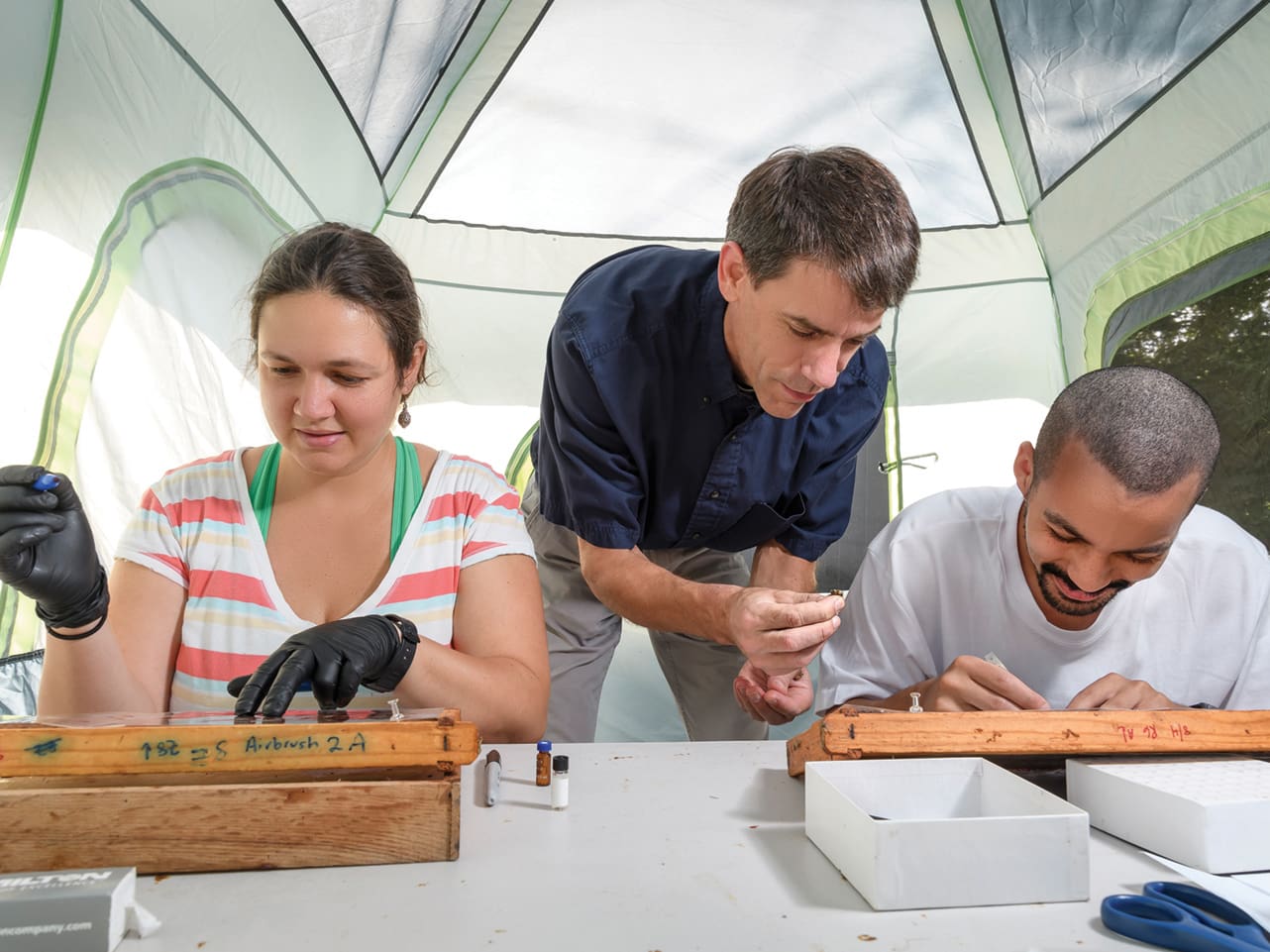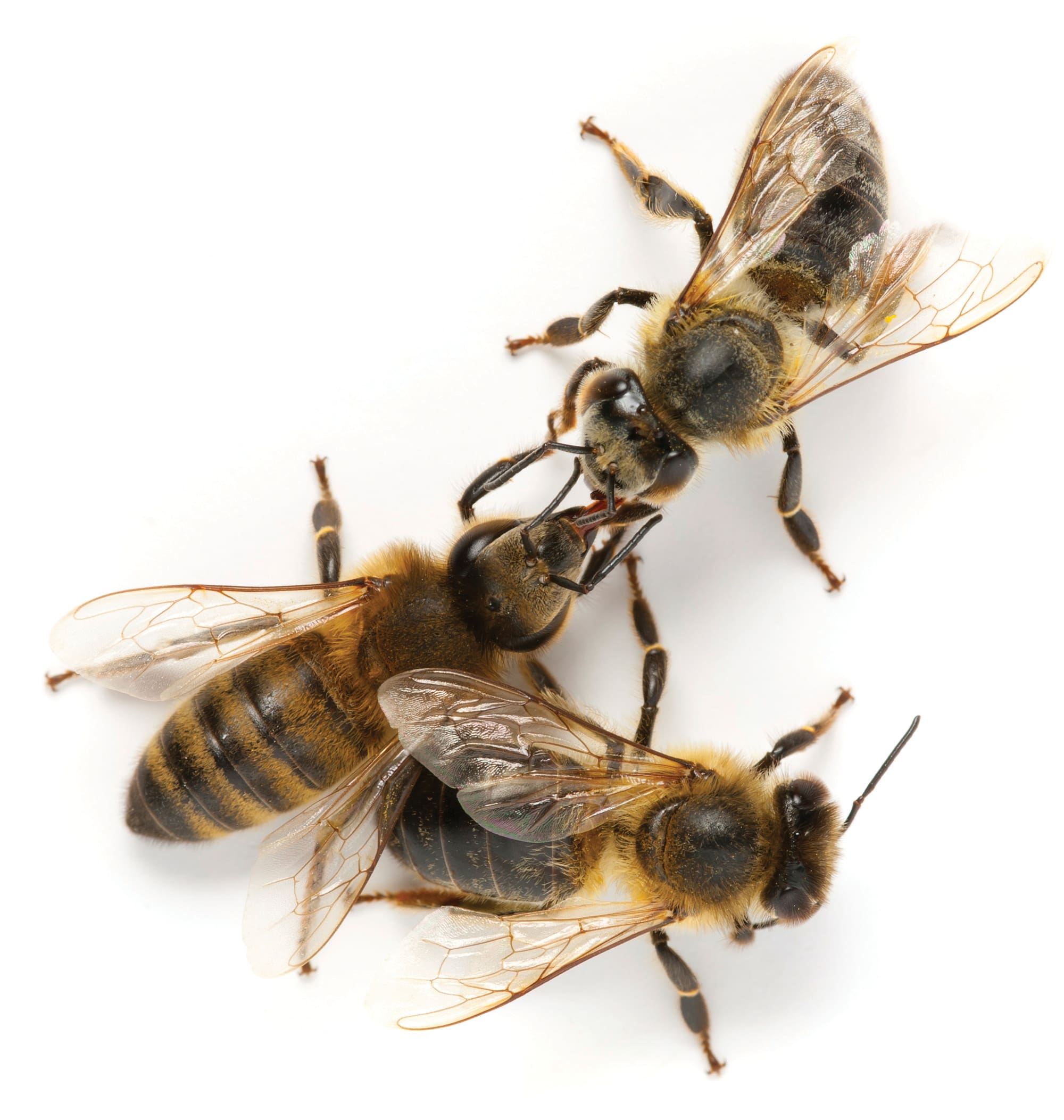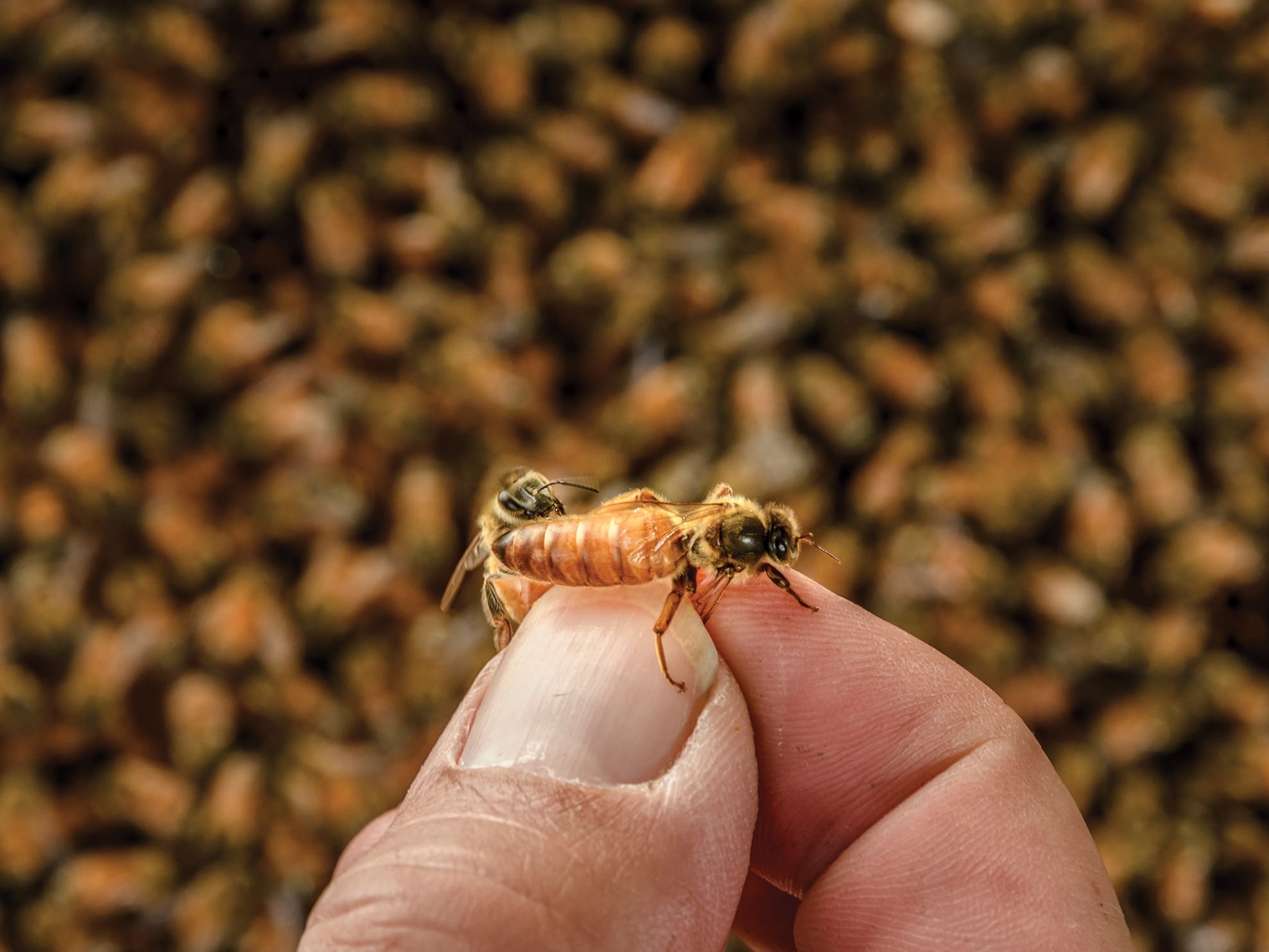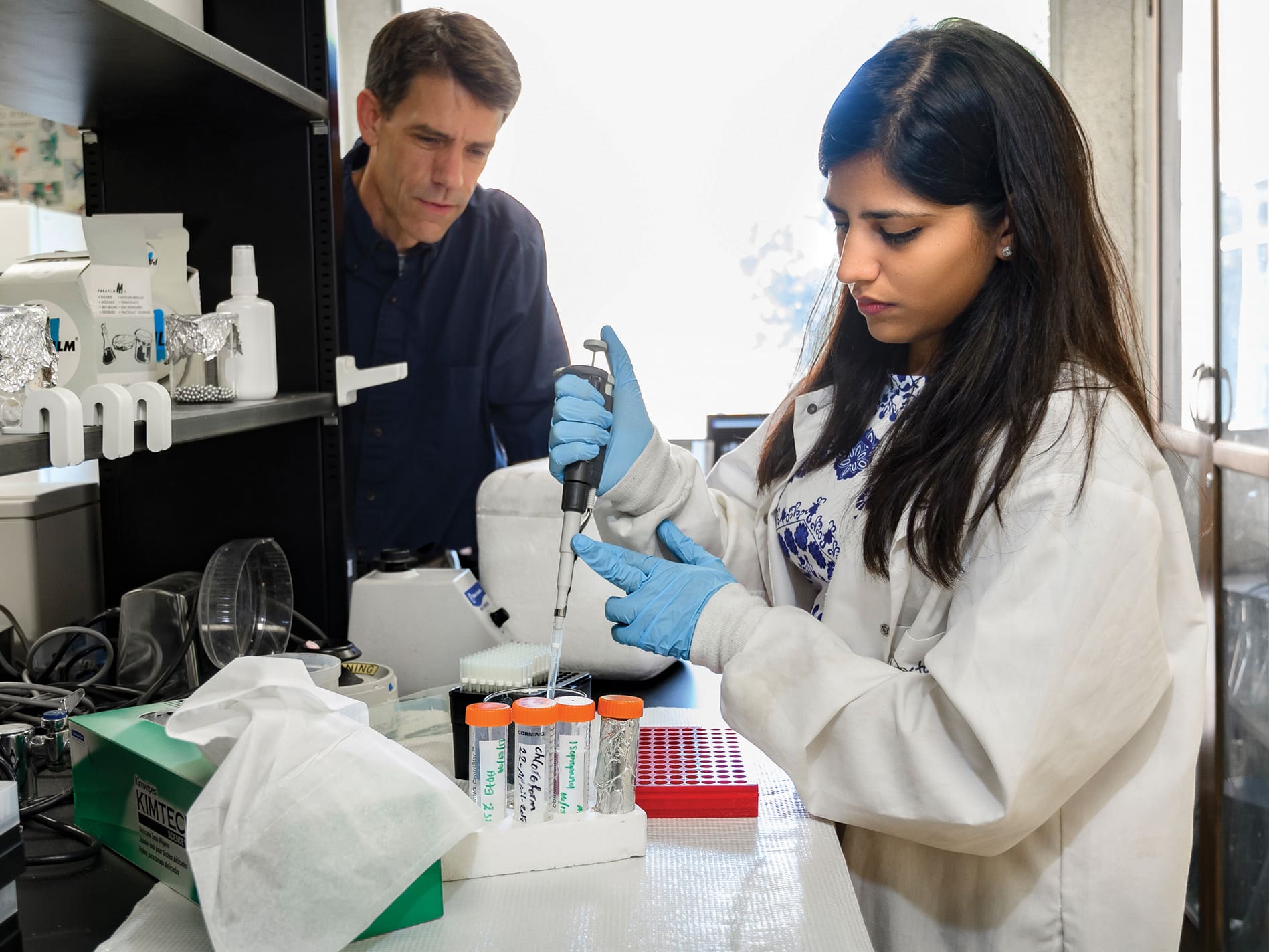
Research from the Hive to the Lab
Dozens of young honey bees swirled and buzzed through the air on the warm, late June day. The two undergraduates, though, weren’t sure how to proceed. Collecting bees for research purposes isn’t covered in most classes.
UNCG’s Sara Rubio Correa and Erin Estes, a Northern Michigan University ecology and mathematics major visiting UNCG for the summer Math-Bio Research Experience for Undergraduates program, asked Professor of Biology Olav Rueppell for help. Dr. Rueppell, who runs UNCG’s Social Insect Lab, was happy to demonstrate.
He eschewed the beekeeper’s hood and other protective gear and seemed oblivious to the dozens of bees swirling around him. Young bees like this, it turns out, rarely sting.
Removing a frame of honeycomb from the hive, he gently knocked some of the bees into a plastic funnel. They fell through the funnel into clear plastic cups — the kind you might otherwise use for an iced latte on a day like this.
The two students observed from several feet away.
He moved briskly, and in less than five minutes had collected several cups of bees for the two students to take back to the lab.
The bees were headed inside to be sedated and then studied — all part of PhD student Shilpi Bhatia’s research to better understand if some strains of honey bees are more virus-resistant than others.
The virus resistance project is one of several studies underway in Rueppell’s lab, where he and more than a dozen undergraduate and graduate students are working to better understand how honey bee genetics, behavior, and health fit together. That research could lead to ways to strengthen the health of honey bees, which are critical for our food supply.



A HIVE OF RESEARCH
The lab is quiet — no buzzing here — but still busy. An undergraduate, biology major Saman Baral, is entering data into a spreadsheet about the survival rates of different groups of bees from Bhatia’s research.
A few feet away at a lab bench, doctoral candidate Carlos Vega Melendez is showing another undergraduate, biology major Kevin Le, how to measure the size of honey bee eggs photographed through a microscope. Vega Melendez’s own research looks at how gene expression changes in bees when they’re exposed to stress at different stages in their egg-larva-pupa-adult life cycle.
In this case, they’re stressed by exposing them to higher-than-normal temperatures — about 113 degrees Fahrenheit.
“We saw very subtle differences in gene expression,” says Vega Melendez, who’s been working with Rueppell for four years and plans to finish his PhD by December 2018. “Some intriguing genes were overexpressed in the stressed bees,” adds Rueppell.
That in turn leads to other questions: Are stressed bees more or less vulnerable to disease? Does their behavior change, and if so, does it do so in ways that are helpful or harmful to the overall health of the colony?
The work in Rueppell’s lab follows two rails of research.
First, he wants to better understand fundamental biological problems, such as how genes influence behavior. Honey bees, which are social insects, had their genome fully sequenced more than 10 years ago, and so are a good organism for this kind of research. The insights gained can be translated to other organisms, from ants to human beings.
Second, Rueppell believes that by better understanding how genetics and the environment interact in honey bees, he and other researchers may be able to help beekeepers keep their hives healthier, and therefore help us all.
Humans have worked with bees for centuries, harvesting honey and beeswax. But in the last decade or so, bee populations have declined markedly. Colony collapse disorder, where most worker bees disappear from a hive and leave the queen to fend for herself, is just one well known but poorly understood cause.
“Colony collapse disorder is sort of the tip of the iceberg,” Rueppell says. He ticks off a range of other problems: less diverse food sources, pesticides, diseases and mites, and lifestyle-related stress.
Lifestyle-related stress? For insects? We’ll get back to that.

“There are two models of how we, as a society, solve problems,” says Rueppell. “One is a garden hose approach. When there’s a fire, we call for the hose — targeted research — to try to put it out. The other is the reservoir approach, where we accumulate knowledge into a reservoir. We can dip into that pool whenever a fire breaks out. For me personally, most of my basic research has given me scientific tools and ways of thinking. That put me into a position to contribute to the applied problem of declining honey bee health.”
A STICKY PROBLEM
Rueppell and his students aren’t the only ones concerned about bee health. Beekeepers typically lose 20 to 40 percent of their bees each year — millions of bees for a single commercial beekeeper.
These losses threaten their business model and our food supply. That’s because honey bees do a lot more than just make honey. In fact, making honey is just a nice side benefit of their arguably more important function: pollinating billions of dollars of produce each year.
“There are thousands of wild bees in the U.S. as well, and their value is quite important,” Rueppell says. “But in the agricultural landscape that we have modified so extensively, most of these wild pollinators can’t survive. We have to rely on the honey bee for at least a good part of the pollination services.”
Go into the produce section of a grocery store and look around; without honey bees, many of the fruits and vegetables you see simply wouldn’t be there. By some estimates, honey bees add about $15 billion in value to U.S. food production each year.
Commercial beekeepers, who can own thousands of hives, transport hives across the country to farms to pollinate crops such as broccoli, peppers, and almond groves each year.
This brings us to the matter of bee lifestyle.
“The commercial bees get shipped all over the place in trucks,” Rueppell says. “They are usually kept in very high density conditions, where 20 or 30 bee colonies are right next to each other.
“If you think about the naturally evolved context, they lived in tree cavities and the next colony was a mile away.”
Imagine how you’d feel if you grew up in a small, rural town where you knew everyone, and then you were relocated to New York City and forced to live in a crowded, noisy high-rise. You’d be stressed, too. Bees, however, can’t take yoga classes.
In addition, their agriculture use means that many bee hives get most of their nutrition from a single crop or a small number of crops, rather than the diversity of plants they’d encounter in the wild. And they can be exposed to pesticides. It’s tough to be a honey bee these days.
“These beekeepers are doing a fantastic business in trying to restart, split their colonies, and manage as well as they can,” Rueppell says. “But they’re running out of tools. We need easy, long-term, sustainable solutions for improving honey bee health.”



CLEANING UP MITES
Work in Rueppell’s lab by PhD-candidate-turned-postdoc Kaira Wagoner may turn into one of those tools. To understand Wagoner’s research, you must understand one of the biggest threats honey bees face: varroa mites.
The mites, also called Varroa destructor, are tiny, rust-colored arachnids, just barely big enough to be seen with the naked eye. They prey on bee larvae, sucking their blood when the larvae are defenseless in the cells of honeycombs. Not only do varroa harm and sometimes kill bees in the larval stage, they also transmit deadly viruses.
If you can stop the varroa, you can protect bees from the mites and from the diseases they carry. Some treatments, such as pesticides, can potentially hurt bees. Wagoner discovered something that may be much better.
For her doctoral dissertation, she studied bee hygienic behavior. Worker bees sometimes open honeycomb cells that contain larvae and, if they find mites, remove the parasitized larvae, leaving healthy ones to continue growing. This behavior gives bees a way to police their own hives against varroa.
But how do bees know when to do this?
Wagoner identified a chemical signal — a biochemical alarm that triggers bees to start the hygienic behavior. If further studies prove out, it may provide beekeepers a simple way to treat hives they suspect have varroa infestations. Simply spray the chemical in the hive, and the worker bees will be triggered into hygienic behaviors, eliminating varroa mites themselves.
Researchers may also use the insights gained by the Rueppell lab to breed healthier bees that are more responsive to the chemical alarm.

Above, a researcher extracts a honey bee pupa from its cell to investigate chemicals on its exterior that might trigger hygienic behavior.
This year, the Rueppell lab won a $999,000 U.S. Department of Agriculture grant to continue its varroa mite research. They’ll collaborate with three other universities, extension specialists, and beekeepers in North Carolina and Minnesota to test their innovations and share lessons learned. The ultimate goal is to help the honey bee industry nationally and globally.
TO BREED BETTER BEES
Humans have been breeding bees for probably centuries.
“Even looking at today’s bees, we can see the impact of selection,” Rueppell says. “Beekeepers want docile bees that produce lots of honey.”
But some of those breeding decisions may have had unintended consequences for bee health. Take the push for honey, for example. Modern honey bees have been selected in part to maximize how much honey they produce. Since they produce more honey, that means they gather less of a substance called propolis, Rueppell says.
Propolis is a sticky, resin-like substance bees collect from plants. They use it to seal off cracks in their hives. But because it’s sticky and gooey, it tends to get all over beekeeping equipment and make it tougher for keepers to maintain their hives. But, Rueppell says, research shows that propolis has antimicrobial properties and helps keep bee colonies healthy.
“So maybe we have to breed that back into the bees,” Rueppell says.
The idea that we can breed stronger, healthier bees is an important one that Rueppell and his students are approaching from multiple angles. The mapping of the honey bee genome allows them and other bee researchers to look at bee traits in a very precise way.
Another tactic that’s getting a lot of attention is breeding bees that are more disease resistant. Bhatia’s research could provide insight on that.
The bees that undergrads Rubio Correa and Estes were collecting were one of several distinct strains from across the country that grad student Bhatia is deliberately infecting with two major honey bee viruses: Israeli Acute Paralysis Virus and Deformed Wing Virus. The first has been linked to colony collapse disorder. The second is one of the diseases spread by varroa mites.
Everybody in Rueppell’s group hopes that what they learn can help improve honey bee breeding for sustainable apiculture.
Understanding genetic differences around things like disease resistance or likelihood to engage in hygienic behaviors is just the beginning of this research. Making it commercially applicable produces its own challenges, Rueppell says.
“At the moment, the selection scheme for making hygienic bees is very labor intensive,” he says. “It involves liquid nitrogen.”
That’s where Rueppell and the young scientists he’s educating in his lab come in.
“There’s a lot of talk about breeding healthy honey bees at the moment and increasing their natural defenses through selective breeding,” Rueppell says. “But you have to understand the genetic architecture and the constraints that the system has for breeding. There’s a lot you need to know to be successful in creating those breeding programs.”
The students and researchers in Rueppell’s lab, from undergraduates to postdocs, all have a role to play — a bit like honey bees in a hive. Many of them — perhaps most of them — will go on to something besides honey bees. But before they do, they will have learned some science and contributed a bit of new knowledge to what we know about honey bees.
And they will take with them new skills and valuable experience, no matter where they go when they fly off to the next stop in their careers.
“I learned how to design and conduct a research project from beginning to end,” says undergrad Rubio Correa of her summer in Rueppell’s lab. “I now have an understanding of what a researcher does.”
She also discovered that, regardless of what your seasoned bee-researcher professor does, you don’t have to follow his example when it comes to protective clothing while working with bees.
“Fear only came along when bees were old enough to fly and could sting,” she says. “As long as I had the proper clothing, my fear would dissipate.”
Article by Mark Tosczak. Photography by Martin W. Kane. Originally published Fall 2017 in UNCG Research Magazine.